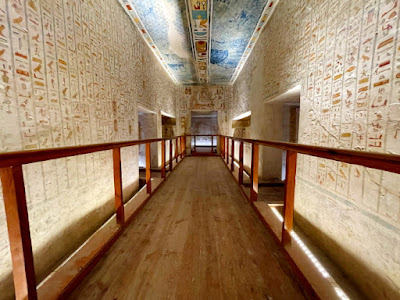Valley of the Kings is one of the main attractions when visiting Luxor. There are 63 known tombs in the Valley and it is believed that there are several more tombs that have never been discovered. Since we only had time to visit a small number of the tombs, our guide "Rocky" picked for us Tutankhamun, Ramses IV, Ramses IX, Merenptah, and Seti I. They were all close together in the same area of the Valley.
Tutankhamun ("The Boy King") is one of the most well-known Kings because his tomb was not discovered until 1922. Grave robbers had taken many of the most artifacts from the other kings' tombs; but King Tut's tomb was still sealed and the treasury was intact when discovered. Items from the treasury are now on display at the Egyptian Museum in Cairo, but will soon be transferred to the new museum that has not yet opened at Giza.
Tutankhamun's tomb is the smallest of the other kings' tombs because he unexpectedly died when he was only 19 years old and there was not time to build a larger tomb for him. Instead, a tomb that was under construction for someone else was converted to his final resting place. There was no time to completely decorate the entire tomb, so only the burial chamber is decorated.
Tutankhamun's mummified body has been returned to the tomb and now lies protected in the burial chamber. This is the only mummy on display in the Valley. To respect the dignity of the kings and royal people that were mummified, I am not including any pictures of unwrapped human mummies in my blogs.
 |
| Picture by Kolohe |
 |
| Picture by Kolohe |
 |
| Picture by Kolohe |
 |
| Picture by Kolohe |
 |
| Picture by Kolohe |
 |
| Picture by Kolohe |
 |
| Picture by Kolohe - Opening of the Mouth Ritual |
 |
| Picture by Kolohe - Ay Performing Opening of the Mouth |
 |
| Picture by Kolohe - Tutankhamun with the Gods |
 |
| The Imy-Dwat |
 |
| Picture by Kolohe |
 |
| Picture by Kolohe - Book of the Dead |
Ramses IV came to power in about 1155 BC after his father was killed in a battle. He was not a strong leader and his reign was considered to be the start of the declining power of the Egyptian empire.
On the tomb walls are many writings from the Book of Gates, Book of Caverns, Book of Nut, Book of the Night, and Book of the Earth.
An ancient plan of his tomb was found on preserved papyrus and indicates that the burial chamber was made by enlarging a pillared hall. Apparently he died before the tomb was completed and there was no time to build a larger burial chamber. His sarcophagus is still in the burial chamber.
 |
| Picture by Kolohe |
Pictured below is a "solar boar from the Book of Gates, 1st division, with a kneeling figure of the king offering Ma'at to the sun god."
 |
| Picture by Heather |
 |
| Picture by Kolohe |
 |
| Picture by Kolohe |
 |
| Picture by Heather |
 |
| Picture by Kolohe |
 |
| Picture by Heather |
 |
| Picture by Kolohe |
The tomb walls of Ramses IX contain passages from the Amduat (Book of What is the Underworld), Book of Caverns, Book of Earth, Book of the Day, Book of the Night, and Book of the Dead. There is no sarcophagus in the burial chamber.
 |
| Picture by Heather |
 |
| Picture by Heather |
 |
| Picture by Kolohe |
 |
| Picture by Kolohe |
 |
| Picture by Kolohe |
 |
| Picture by Kolohe |
 |
| Picture by Kolohe |
 |
| Picture by Kolohe |
 |
| Picture by Kolohe |
 |
| Picture by Kolohe |
 |
| Picture by Heather |
 |
| "The sun boat of Khnum guided by the benign serpents, the ancestors and the gods Hathor and Horus." |
 |
| "Two protecting genii with the serpent Sokaris and the Scarab of the Rising Son" |
 |
| Picture by Kolohe |
 |
| Picture by Kolohe |
The burial chamber was not open to the public; but because I was such a nice person, and for other considerations, the guard looked the other way and I was allowed to crawl under the gate and go down to the chamber and take a few pictures.













































































No comments:
Post a Comment